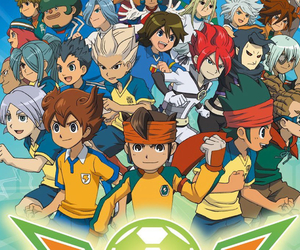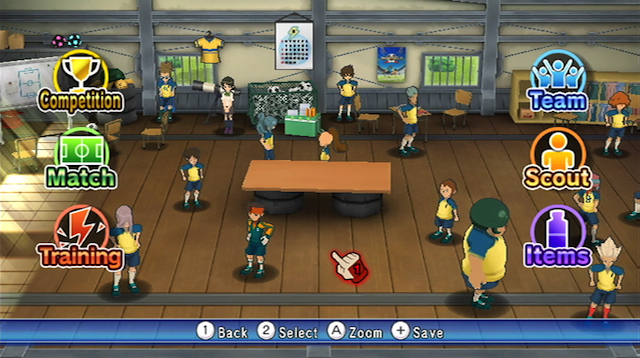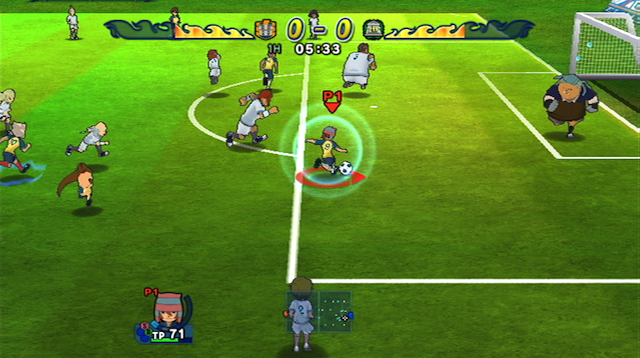Inazuma Eleven Strikers Review
 Game: Inazuma Eleven Strikers
Game: Inazuma Eleven Strikers
Developer: Level-5
Publisher: Nintendo
Available on: Nintendo Wii only
The Inazuma Eleven series has really taken off in Europe over the last few years. Although it has been a big thing in Japan for quite some time, the games – and with it, the associated Animé – have only recently been translated from Japanese. Inazuma is unique in the sense that it is a football game, where you can directly play the matches, but it also combines many JRPG elements into proceedings, with social links, item collection and levelling up all important aspects to consider. The cartoon has obviously brought the series to the mainstream a little more and now the series, that has so far been exclusive to the Nintendo DS, has arrived on the Wii.
STORY: The series normally follows Mark Evans, a talented young goalkeeper who has organised a football team for his school, and is now taking on some of the best young teams from around the world. However, this Wii version of the game is a much straighter football title, and most of the RPG elements and story-based gameplay has been dropped for the title, making this a game that comes across more as a tie-in with the cartoon that is currently showing on ITV, rather than a fully-fledged entry into the series. The story is never even really touched upon, and instead you simply play in a series of tournaments that re-creates some of the most famous matches from the Animé. The game even starts with an extended montage of clips from the cartoon, so it sets the tone of what we should expect from the title. It is a shame really, as these are the things that make the Inazuma games stand out from other sports games.

GRAPHICS: The whole game has a cel-shaded cartoon look, which suits the title perfectly and ties in with the animated feel that you would expect from the game. Animations are striking and over the top, especially when a special move is executed, and the colour palette is bright and bold, making all of the characters look very expressive as well as making the game exciting to watch. Stadiums and pitches are a bit more plain and understated, but the action in-game is so fast-paced and frantic that you aren’t really looking at the scenery as you play. The menus and presentation still maintain the RPG influences, and this certainly doesn’t look like your typical FIFA Soccer with a slick design and booming pop music; this remains a very Japanese affair.
SOUND: The game also maintains the same feel in the audio department, with high-tempo animé style music booming out throughout the menus as well as during the games, in an attempt to inject the excitement and atmosphere of the television series into the title. This also goes all the way down to the voice-overs, which make full use of the actual voice cast of the cartoons. However, that isn’t to say it is all perfect, as the voice clips tend to repeat far too often, For example, the number of times that you will hear your team members shouting “let’s go” during a game or a training session is far too high, and the match commentator doesn’t have enough phrases and will soon become irritating; even in a match with halves as short as three minutes.
GAMEPLAY: To put it simply, the game plays a lot like Mario Strikers Charged Football. You do have full eleven-a-side teams however, and you control the players directly, switching from one to the next. Basic moves are what you would expect – passing, shooting, sprint and evade – which are all complemented by a series of special moves that are character-specific and can be pulled off once you have built up enough Inazuma points; which are accrued as you play through a match and perform successful passes, tackles and attempts on goal. These are either defensive/blocking ones, which take the form of speed boosts or attacks and allow you to escape defenders, or take the ball off the opposition.

The most important special moves though are the super shots, which are just as over-the-top as the power shots in Mario Strikers. The normal shots are so over-powered that they render regular shots useless. If you ever score with a normal shot, it will be a small miracle, so super shots are a must. Once your Inazuma bar is filled, you can hold down the shoot button to charge the super shot – holding it for longer increases the power of the shot if you have enough in your meter – and this, in turn, increases the chance of the shot beating the super save of the opposition’s goalkeeper.
These do liven up the game, as each character has a different power, some summon wind dragons, others a magical unicorn, or some more conventional power moves. They will all add a bit of variety to proceedings, but regardless of this, they do get repetitive, and you cannot skip the sometimes very long-winded cutscenes that appear when you pull off the move. You cannot skip these either, so prepare to sit through twenty or thirty of these in each game. The games do tend to become a series of special move cutscenes, and this does break up the flow of the gameplay to quite a large extent; unfortunately this sometimes makes the action become a little irritating.
MULTIPLAYER: When you get several friends together, the action definitely gets more frantic and the game does become a lot more fun. The story isn’t there to keep you interested in the single player mode, so why not grab a few friends to make the action more intense. Up to four players can take part, with co-op or competitive play being an option, and with everyone pulling off their own special moves, it does become even more crazy and action-packed than normal, and this is indeed a lot of fun. In four player mode, there is even the option for one player on each team to take control of the team coach or manager, who – with the press of a button or waggle of a Wii Remote – can issue instant tactical re-shuffles and add power boosts to special moves. This is a totally different gameplay experience, and it is nice to see someone trying something different in a football game, despite the genre conventions being so well-established. Up to four players can also choose to take on the five training mini-games together, and this seems more like a Mario Party style game mode, and is more of an extra than a core gameplay element; it is very likely that these won’t keep you and your friends entertained for long.

LONGEVITY: Without the strong story mode from the DS series, the game doesn’t have much long term appeal. Other than single matches and tournaments, there is a team management mode that you can take part in, which puts you through pre-determined tournaments, and also allows you to take part in training mini-games. These require you to hammer the buttons to perform strength training, or press the at the right time in order to kick a ball. These are all quite funny, and are quite short, so they are more of a diversion from the main game than a natural extension.
These different activities, as well as just playing matches, will help your team level up and gain teamwork bonds with team-mates. You can even scout (read: poach) players from beaten opponents teams. Whilst these do improve the number of times you can pull of specials in a match without tiring for instance, or allow you to pull off co-op special moves when you work well together, they aren’t really imperative and you could get through the game ignoring them entirely if you wished. The fact that there is no true story mode will limit re-playability and it lacks any of the depth of the DS Inazuma titles.
VERDICT: If you want the deep and involving gameplay that has made the Nintendo DS Inazuma Eleven series so popular, you are really looking in the wrong place here. The Wii has a sometimes unfair reputation for being just a casual or mini game console and this title does nothing to alleviate that image. Fans of the cartoon series will no doubt like the game, the sounds and visuals are more authentic and more impressive than in previous games, and come very close to the TV series, but gamers who want to experience the exploration and developmental elements that are so key in the original versions of Inazuma will be sorely let down by this “lite” instalment into the series.






